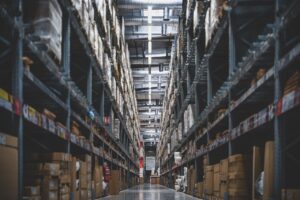Introduction
We want to learn and discuss the benefits, cost and strategies of DTC fulfillment, but before we begin, we would like to offer a clear overview of what DTC fulfillment is. DTC stands for Direct-to-Consumer fulfillment. This refers to companies or ‘DTC brands’ that sell to consumers, often via the Internet. These DTC brands will warehouse and ship the purchased products directly to the consumer, or they will utilize a 3PL provider. This means there is no wholesale company representing and distributing the products – it is coming to the consumer directly from the manufacturer. The warehousing and fulfillment can be handled in-house by the brand, or the brand can partner with a full-service fulfillment center in order to accomplish the fulfillment.
DTC fulfillment means direct sales – the creator sells directly to the consumer. This allows the DTC brands to have control over the entire process from creation to branding, advertising, packaging, shipping – and most importantly the overall customer experience. DTC fulfillment eliminates intermediaries such as wholesalers and retailers, so the full responsibility for the consumer experience is with the DTC brands.
One more advantage the DTC brands have is the possibility of faster delivery by managing their logistics or by utilizing an ecommerce fulfillment center, especially the full service fulfillment. Perhaps the most important advantage enjoyed by DTC brands would be the opportunity for relationships with customers that are personal. This often leads to a ‘customer for life’ for the DTC brands.
What Are the Benefits of DTC Fulfillment?
We have offered an overview of some of the benefits, now we’ll do a closer look. DTC brands have greater control over brand messaging, and that is Benefit #1. Of course the one that creates the product will have the best messaging regarding their product. Having the marketing completely in control of the creator is definitely a benefit. It follows that the experience of the customer will be in the control of the DTC brands, which is an important Benefit #2.
More benefits could be operational efficiency #3 resulting in cost savings and better profit margins, benefit #4. Some DTC brands do their own warehousing and fulfillment, but many turn to a full-service fulfillment center. A top tier ecommerce fulfillment center, such as AMS Fulfillment, will absolutely increase operational efficiency and lead to cost savings.
Finally, we will return to the customers. DTC brands will have access to direct consumer data, telling them which consumers are purchasing what. This can lead to increased personalization opportunities, recognizing the loyal customers and personalizing the brand in the eyes of the customer.
Key Components of Effective DTC Fulfillment
The fulfillment of orders received by the DTC brands can be done by the company itself, or by a fulfillment center that is qualified to handle the warehousing, pick and pack and shipping of orders. The key components of effective DTC fulfillment are considered to be the optimization of inventory distribution, the integration of advanced technology, and the ability to do demand forecasting and to prioritize it.
It stands to reason that a full-service fulfillment center will have an advantage in these areas, as the entire focus of the company is to provide exceptional fulfillment services. A 3PL provider will likely have more than one location, which of course allows for the optimization of inventory distribution, allowing the company to locate its inventory closer to the customer.
Another benefit of a top-notch fulfillment center would be its technology. A fulfillment center will have the best inventory management technology, and other forms of technology as well, including managing the warehouse and locating the best shipping prices.
One more thing the DTC business needs is excellent forecasting of the customer demands, which if done well will allow the company to always have sufficient supply at the right times and the right seasons. Demand forecasting takes skill and time, and it should be prioritized by the success-oriented DTC brands.
Strategies for Implementing DTC Fulfillment
DTC brands that intend to fulfill and ship orders in-house will need to invest more than a little money and time and energy in building their fulfillment operations capacity. Strategies for implementing DTC fulfillment must include building scalable fulfillment solutions, leveraging data analytics for decision-making and managing high-order volumes efficiently. Considering the skills, knowledge and investment that go into actually excelling at DTC fulfillment, many DTC brands do turn to a 3PL provider for fulfillment.
What DTC fulfillment involves is a very basic process beginning with the product – the brand has a product to sell. Next we look at the customer placing the order for the product. That entails having a website or online location for the purchase to be made. The order will be processed through the system of technology, which means that the DTC business will need to have very good inventory management software so that when the order is received it identifies the product and initiates the fulfillment. Then the order must be picked and packed and readied for shipping. Finally, the product will be shipped, reaching the satisfied customer within the agreed upon time frame.
If the fulfillment is accomplished by a fulfillment center, the DTC business will focus upon the creation and improvement of the product, the marketing of the product and the relationship with the customer. Understandably, many DTC brands do choose to outsource the fulfillment portion of the process to a full-service provider.
Sustaining Long-Term Success in DTC Fulfillment
Long-term success in DTC fulfillment will come from one place… and that is the customer. Customer loyalty is gained when the product is what the customer wants, it is easy to purchase, and it arrives at the customer’s address within the agreed upon time frame. Long-term success comes first and foremost from customer loyalty.
Secondly the DTC business must be very attentive to market trends and customer expectations. Also there should be a focus on sustainability and environmentally friendly practices. In today’s world customers are attentive to the environmental impact of their purchasing, and giving attention to sustainability will definitely lead to long-term success.
In Closing
We have done our best to give readers a look into the benefits of DTC fulfillment, and they are many. There does seem to be a trend toward DTC fulfillment and toward relationships and communication with consumers. Many of AMS Fulfillment’s clients are highly successful DTC brands. AMS is committed to its clients, always keeping partnership at the front line. AMS is very familiar with the benefits, costs, and strategies of DTC fulfillment and we excel at serving our clients in the direction of long-term success.
Please feel free to contact AMS Fulfillment if you are looking for the right fulfillment partner.




